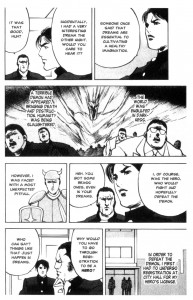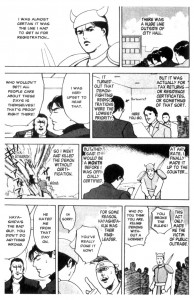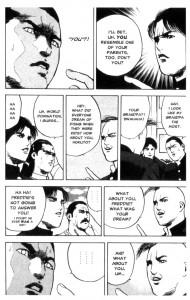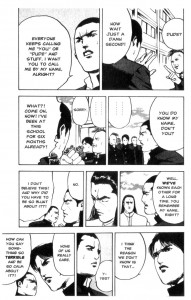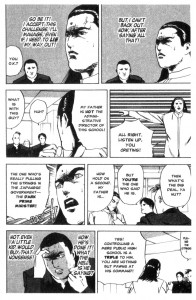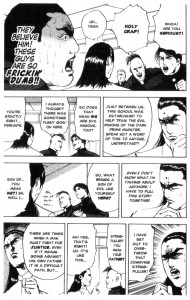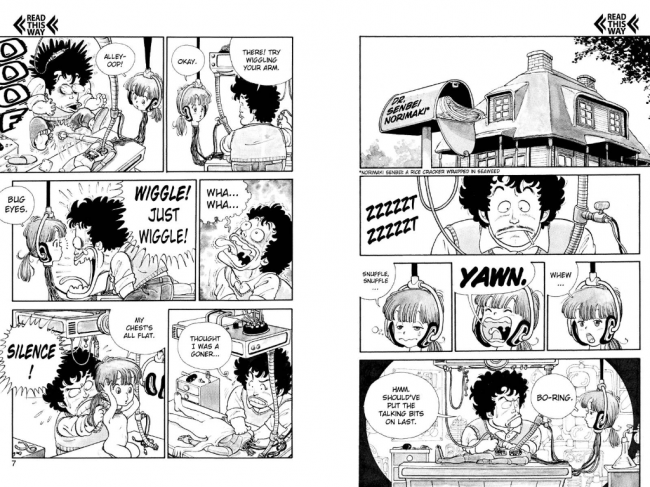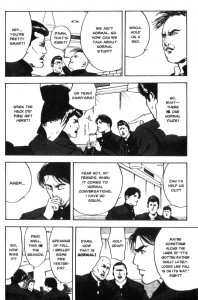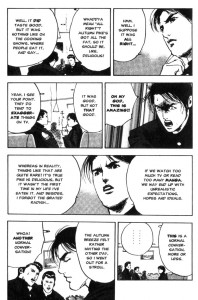
 Shotaro Ishinomori’s Cyborg 009 (ultra-cheap DVD
Shotaro Ishinomori’s Cyborg 009 (ultra-cheap DVD , used book
, used book ) has one of my favorite concepts for any story ever. Nine humans are kidnapped by the Black Ghost, a terror organization, and turned into combat robots. Each person gets a specific powerset — some can fly, others are telepathic — and a swanky new costume. Instead of being used to wreak havoc all over the world, though, the nine robots manage to escape from the Black Ghost, thanks to a helpful scientist, and decide to fight back against their masters. (The Skull Man is a pretty great look at the origins of the Black Ghost organization.)
) has one of my favorite concepts for any story ever. Nine humans are kidnapped by the Black Ghost, a terror organization, and turned into combat robots. Each person gets a specific powerset — some can fly, others are telepathic — and a swanky new costume. Instead of being used to wreak havoc all over the world, though, the nine robots manage to escape from the Black Ghost, thanks to a helpful scientist, and decide to fight back against their masters. (The Skull Man is a pretty great look at the origins of the Black Ghost organization.)
It’s a simple concept, but a good one, nonetheless. The cyborgs go up against spies, terrorists, armies, other cyborgs, giant robots, and monsters. Cyborg 009 has a lot of super sentai appeal, but I like how easy it is to update the concept to the modern day. The series dates from the ’60s, of course, and features fears and anxiety that’s rooted in that time period. But the concept is just loose enough that as long as you have the Black Ghost eager to upset the status quo and nine humans who are upset at how they’ve been treated, you can apply it to almost any time period. Later this year, Kenji Kamiyama’s 009 RE:CYBORG drops, which brings the series fully into the modern day. There’s a trailer here, which I think does a great job of showing off how cool these cats are.
Part of the fun of the series is that each cyborg has a certain power. Joe Shimamura, Cyborg 009, is the hero (more or less) and can move at super-speed by activating a circuit. 001, Ivan Whisky, is telepathic, and also a baby. Jet Link is 002, an American that has been given the power of flight. Each of the nine cyborgs has a specialty, so they all have their chances to shine. They’re a team, and they have to figure out how to work together and battle the Black Ghost at the same time.

I love the costumes, too. The giant buttons that Ishinomori gave them are fantastic. They’re straight out of Walt Disney, and lend the whole affair a cartoony, child-like feel. The golden scarves are the perfect example of “too much” actually being “just enough.” The scarves are a great visual, especially when the characters are in motion, and are an iconic touch at this point. A certain class of hero needs a cape to project majesty, and the scarves do that while also being distinctive. The cyborgs look decidedly sci-fi, and actually pretty retro sci-fi. They’re from the future of 1966.
I like all the cyborgs, but 008 has a special place in my heart. He’s the black dude, called Pyunma, and the only actual soldier in the crew. His power is that he’s able to function extremely well underwater, both in terms of surviving indefinitely and deploying sea-based ordnance. Also, he’s drawn like this:



WHOA.
I hate this stuff. It’s racist and ugly, and stupid on top of that. Ebony White and that one Tintin story just make me angry, in part because that sort of racism is inexcusable but mostly because comics scholars are like “oh, listen, Will Eisner was a legend, how can he be racist? It was the ~times~!” Yes, the times when black people were demonized and dehumanized, ha ha, what a time! Mad Men!
But 008 is a little strange. For one, even though Ishinomori is using explicitly racist iconography, he isn’t bringing the same baggage to it that Eisner or others did. 008 isn’t a Stepin Fetchit type, and there’s not a hint of the “yassuh boss, we’s sick!” garbage that makes Ebony White such a Strong Black Character. He’s just a regular dude, and he acts like it. It’s like Ishinomori adopted the art style but missed out on the baggage that goes along with it.
I can’t help but wonder if part of the reason why 008 is more acceptable to me, and more normal than Ebony, is the subtext of Ishinomori’s story. The cyborg team is international, with members from China, France, the UK, the United States, Russia, Germany, and Japan. They vary racially among that mix, too. 009 is half-Japanese and half-American, which suggests that he’s the son of a military man and a Japanese woman to me, considering the time period. 005 is a Native American. Some of them are broad stereotypes, which varies depending on which incarnation of the series you’re reading, but they’re intentionally from all over the world.



Ishinomori’s exploring the idea of weapons run rampant and what it’ll take to put the world on the brink of war. It’s about money, and how chasing money can make people evil. He brings in an international cast, like Hideo Kojima did in Metal Gear Solid 4, because he wants to illustrate that war ruins everyone and everything. No one is safe, no matter whether you’re a rich ballerina in Paris or a poor farmer out in China.
Something about 008 and his attitude made me more willing to accept him than I would Ebony White or whatever that Tintin comic is. There’s a certain tension between 008’s looks, which have evolved over the years toward “actual human being” instead of stereotype, and the fact that Ishinomori is trying to show us how war affects all of us. I’m interested in that intersection. I don’t know how much contact Ishinomori had with black people, or where he first saw the racist iconography he employed. But I do think it is fair to assume that he employed that same iconography without the same cultural baggage as Eisner or Herge, who did it while reinforcing a very poisonous power structure. It looks like a duck but it quacks like a goose — what is it? It’s infuriating and interesting all at once, and if anything, makes me want to know more about the origins of the series and why Ishinomori made the choices he did. In a later series, produced after Ishinomori died, reinvented 008 as a guerilla soldier, instead of a refugee, which fits in even better with Ishinomori’s simultaneously global and personal focus.
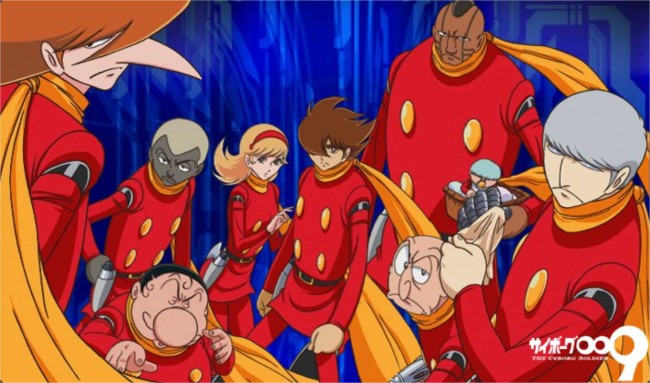
I can see that Ishinomori was trying to tell a story that’s still progressive to this day, one that incorporates warmongering, weapons dealing, and the effects of war on a society. It’s about how war screws over all of us, from the people getting blown up on the front line to the people who don’t realize how often war is used in support of business interests. It’s about weapons possibly being used to prevent that outcome, and the importance of making humane decisions, rather than business-oriented ones, during the course of war. The cyborgs are weapons with free will and minds, and they make choices according to their own morality. That’s impossible with a nuclear bomb or drone. There’s a point there about where warfare and personal actions meet, but I can’t quite grasp it. Are the cyborgs us? Are they the leaders of the world? Just a cool superhero team? Something else?


It sorta bums me out to read a kids’ comic from the ’60s that gets that fact better than a lot of modern pop culture. The new Splinter Cell demo opens with Sam Fisher, American black-ops expert, torturing and murdering a terrorist on the Iraq/Iran border. Sam, if you aren’t familiar with the series, is a hero. The new Call of Duty features Oliver North as an advisor. Ollie North, the same man who funneled weapons to death squads and was involved in narcotics trafficking in order to fund his little hit squads and operations. You know where those drugs ended up? The inner city. He’s the guy consulting on a series that is increasingly less interested in showing the horrors of war, which it kinda sorta almost did at one point, and more interested in showing “AW YEAH!” moments. I mean, the news out of Iraq right now is that they’re pumping out enough oil to possibly make sanctioning Iran in the future easier without disrupting oil markets. I realize that holding up a children’s comic as a great example of social consciousness is stupid… but Ishinomori got it. It’s about money, and then men who control that money and want more of it, no matter what the cost.
It is what it is, I guess. Cyborg 009 is great, and I think Ishinomori has a strong message at the heart of the series. I hope the upcoming movie lives up to it, and I hope people keep reinventing it as time goes on. It’s a timeless idea, which is kind of sad, actually.
BACKUP STORY! CURSE OF THE CRIMSON CORSAIR, FEATURING EIJI NONAKA’S CROMARTIE HIGH SCHOOL ! BUY IT USED!
! BUY IT USED!
